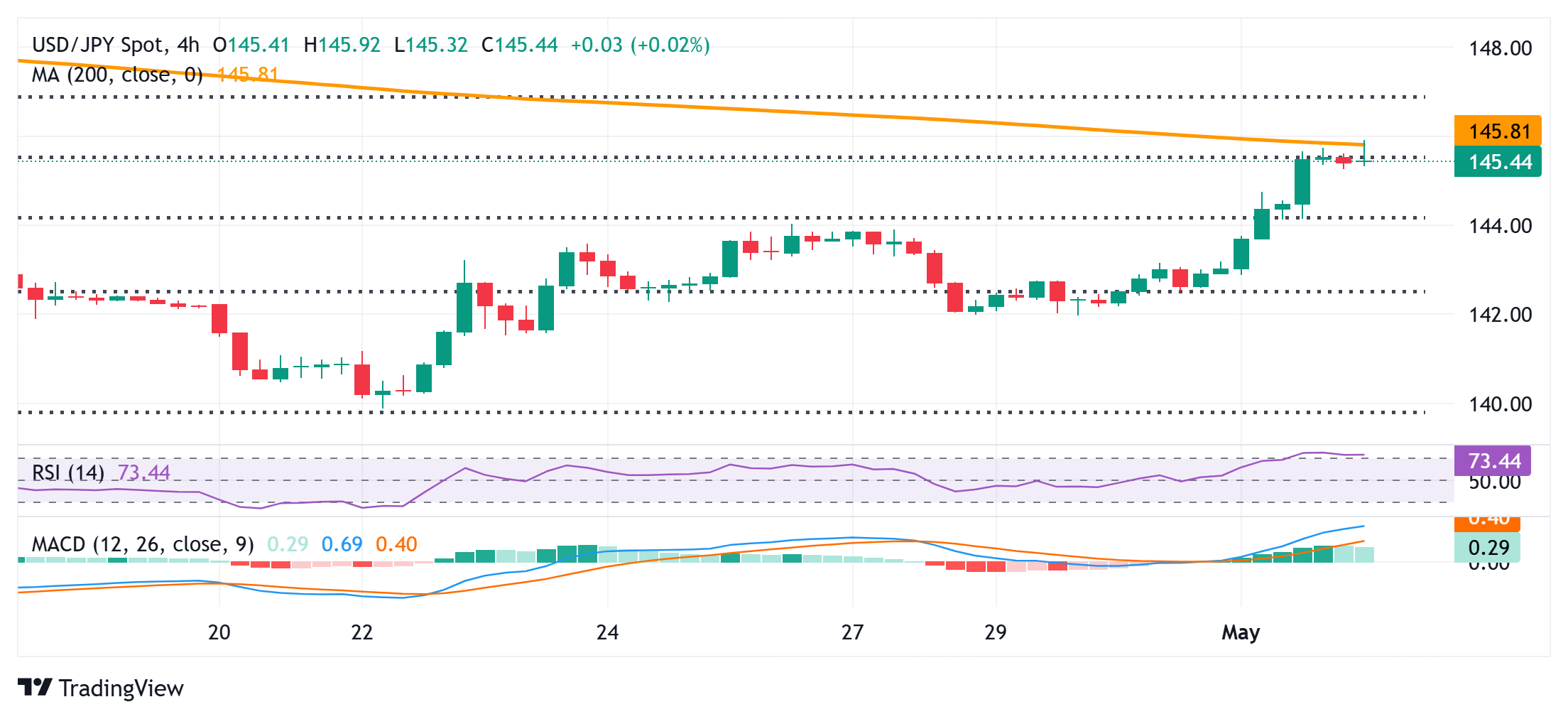Created
: 2025.05.02














![]() 2025.05.02 11:12
2025.05.02 11:12
The Japanese Yen (JPY) continues to be undermined by the Bank of Japan's (BoJ) dovish pause the previous day and drops to over a three-week low against its American counterpart during the Asian session on Friday. In fact, the BoJ slashed its forecasts for economic growth and inflation for the current year amid heightened uncertainty over US trade tariffs. Investors were quick to react and pared their bets on further interest-rate hikes. Apart from this, the optimism over the potential de-escalation of the trade war between the US and China - the world's two largest economies - undermines the safe-haven JPY.
Meanwhile, hopes for tariff deals between the US and its trading partners remain supportive of a positive risk tone. This, along with an unexpected uptick in Japan's unemployment rate, weighs on the JPY. Moreover, the recent rise in the US Treasury bond yields assists the US Dollar (USD) to stand firm near a multi-week top and turns out to be another factor pushing the USD/JPY pair higher for the fourth straight day. However, prospects for more aggressive policy easing by the Federal Reserve (Fed) might cap the USD and lend some support to the lower-yielding JPY ahead of the US Nonfarm Payrolls (NFP) report.

From a technical perspective, the overnight breakout above the 38.2% Fibonacci retracement level of the March-April downfall and the 145.00 psychological mark was seen as a key trigger for bullish traders. Moreover, oscillators on the daily chart have just started gaining positive traction and suggest that the path of least resistance for the USD/JPY pair is to the upside. The subsequent move up beyond the 50% Fibo. level, however, stalls near the 200-period Simple Moving Average (SMA) on the 4-hour chart.
This makes it prudent to wait for some follow-through buying beyond the 146.00 mark before positioning for an extension of the recent goodish recovery move from a multi-month low. Spot prices might then climb to the 146.55-146.60 intermediate resistance before aiming to test the 61.8% Fibo. level, around the 147.00 neighborhood.
On the flip side, the 145.25 area could offer immediate support ahead of the 145.00 round figure. Any further corrective slide might now be seen as a buying opportunity and remain limited near the 144.30-144.25 region, or the 38.2% Fibo. level. A convincing break below the latter, however, might prompt some technical selling and drag the USD/JPY pair below the 144.00 mark, towards the mid-143.00s en route to the 143.20 area and eventually to sub-143.00 levels.
The Japanese Yen (JPY) is one of the world's most traded currencies. Its value is broadly determined by the performance of the Japanese economy, but more specifically by the Bank of Japan's policy, the differential between Japanese and US bond yields, or risk sentiment among traders, among other factors.
One of the Bank of Japan's mandates is currency control, so its moves are key for the Yen. The BoJ has directly intervened in currency markets sometimes, generally to lower the value of the Yen, although it refrains from doing it often due to political concerns of its main trading partners. The BoJ ultra-loose monetary policy between 2013 and 2024 caused the Yen to depreciate against its main currency peers due to an increasing policy divergence between the Bank of Japan and other main central banks. More recently, the gradually unwinding of this ultra-loose policy has given some support to the Yen.
Over the last decade, the BoJ's stance of sticking to ultra-loose monetary policy has led to a widening policy divergence with other central banks, particularly with the US Federal Reserve. This supported a widening of the differential between the 10-year US and Japanese bonds, which favored the US Dollar against the Japanese Yen. The BoJ decision in 2024 to gradually abandon the ultra-loose policy, coupled with interest-rate cuts in other major central banks, is narrowing this differential.
The Japanese Yen is often seen as a safe-haven investment. This means that in times of market stress, investors are more likely to put their money in the Japanese currency due to its supposed reliability and stability. Turbulent times are likely to strengthen the Yen's value against other currencies seen as more risky to invest in.
![]()
Created
: 2025.05.02
![]()
Last updated
: 2025.05.02

FXStreet is a forex information website, delivering market analysis and news articles 24/7.
It features a number of articles contributed by well-known analysts, in addition to the ones by its editorial team.
Founded in 2000 by Francesc Riverola, a Spanish economist, it has grown to become a world-renowned information website.
We hope you find this article useful. Any comments or suggestions will be greatly appreciated.
We are also looking for writers with extensive experience in forex and crypto to join us.
please contact us at [email protected].
Disclaimer:
All information and content provided on this website is provided for informational purposes only and is not intended to solicit any investment. Although all efforts are made in order to ensure that the information is correct, no guarantee is provided for the accuracy of any content on this website. Any decision made shall be the responsibility of the investor and Myforex does not take any responsibility whatsoever regarding the use of any information provided herein.
The content provided on this website belongs to Myforex and, where stated, the relevant licensors. All rights are reserved by Myforex and the relevant licensors, and no content of this website, whether in full or in part, shall be copied or displayed elsewhere without the explicit written permission of the relevant copyright holder. If you wish to use any part of the content provided on this website, please ensure that you contact Myforex.
Myforex uses cookies to improve the convenience and functionality of this website. This website may include cookies not only by us but also by third parties (advertisers, log analysts, etc.) for the purpose of tracking the activities of users. Cookie policy